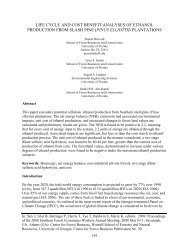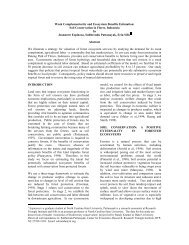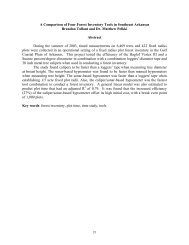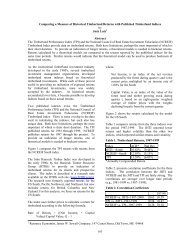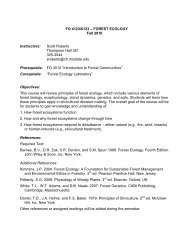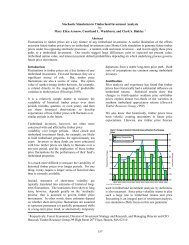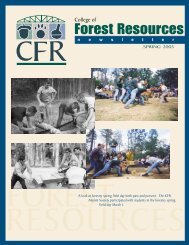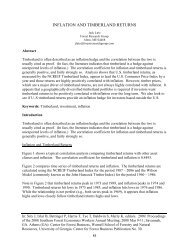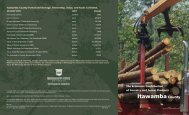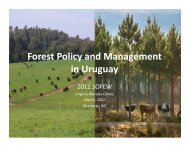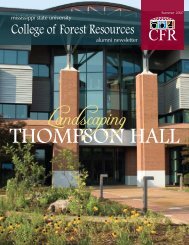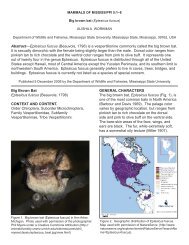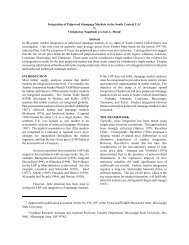Comparison of Private Forestry in Florida and New ick ... - sofew
Comparison of Private Forestry in Florida and New ick ... - sofew
Comparison of Private Forestry in Florida and New ick ... - sofew
Create successful ePaper yourself
Turn your PDF publications into a flip-book with our unique Google optimized e-Paper software.
<strong>Comparison</strong> <strong>of</strong> <strong>Private</strong> <strong>Forestry</strong> <strong>in</strong> <strong>Florida</strong> <strong>and</strong> <strong>New</strong> Brunsw<strong>ick</strong>:<br />
Implications for Canada-US S<strong>of</strong>twood Lumber Dispute<br />
Rebecca L. Gruby, Janaki Alavalapati, <strong>and</strong> Jagannadha Matta 1<br />
Abstract<br />
Grow<strong>in</strong>g concerns for the protection <strong>of</strong> public forests have been prompt<strong>in</strong>g the expansion <strong>of</strong><br />
private forests <strong>in</strong> the United States <strong>and</strong> Canada. Both countries have been implement<strong>in</strong>g a host <strong>of</strong><br />
regulatory <strong>and</strong> <strong>in</strong>centive policies to ensure susta<strong>in</strong>able forest management. These policies will<br />
not only address negative <strong>and</strong> positive externalities associated with timber <strong>and</strong> non-timber<br />
products production, but will also <strong>in</strong>fluence the pr<strong>of</strong>itability <strong>of</strong> forestry <strong>and</strong>, thus, the timber<br />
supply. A comparative advantage <strong>in</strong> the form <strong>of</strong> regulatory or <strong>in</strong>centive policies for private<br />
forestry would add fuel to the on-go<strong>in</strong>g Canada-US s<strong>of</strong>twood lumber trade dispute. In the study<br />
reported here, we conducted a systematic comparative analysis <strong>of</strong> <strong>in</strong>stitutions <strong>and</strong> policies<br />
<strong>in</strong>fluenc<strong>in</strong>g private forestry <strong>in</strong> the US <strong>and</strong> Canada us<strong>in</strong>g case studies from <strong>Florida</strong> <strong>and</strong> <strong>New</strong><br />
Brunsw<strong>ick</strong>, <strong>in</strong> both <strong>of</strong> which private forestry is significant. Our study concluded that though the<br />
regions share a similar burden <strong>of</strong> regulation, the market<strong>in</strong>g services <strong>and</strong> cost-share programs <strong>in</strong><br />
<strong>New</strong> Brunsw<strong>ick</strong> are more extensive than those <strong>of</strong>fered <strong>in</strong> <strong>Florida</strong>. The qualitative results <strong>of</strong> our<br />
analysis help reduce the potential for the extension <strong>of</strong> the current trade dispute to the private<br />
sector.<br />
Key Words: Analysis, <strong>in</strong>stitutions, policy, United States, trade<br />
Acknowledgements:This research was supported by a grant from the University <strong>of</strong> <strong>Florida</strong>’s<br />
University Scholars Program. The authors gratefully acknowledge the assistance <strong>of</strong> Ken Hardie,<br />
<strong>New</strong> Brunsw<strong>ick</strong> Federation <strong>of</strong> Woodlot owners, Phil Gorn<strong>ick</strong>i, <strong>Florida</strong> <strong>Forestry</strong> Association,<br />
Dave Conser, <strong>Florida</strong> Division <strong>of</strong> <strong>Forestry</strong>, Chris Demers, University <strong>of</strong> <strong>Florida</strong> Extension<br />
Forester, <strong>and</strong> Wayne Losano, College <strong>of</strong> Liberal Arts <strong>and</strong> Sciences.<br />
1 School <strong>of</strong> Forest Resources <strong>and</strong> Conservation, University <strong>of</strong> <strong>Florida</strong>, 365 <strong>New</strong><strong>in</strong>s-Ziegler Hall<br />
P.O. Box 110410, Ga<strong>in</strong>esville, <strong>Florida</strong>, 32611-0410. r.gruby@gmail.com. (561) 213-2369<br />
106
Introduction<br />
The past two decades <strong>of</strong> s<strong>of</strong>twood lumber trade between the United States (U.S.) <strong>and</strong><br />
Canada have hosted the longest <strong>and</strong> largest trade dispute <strong>in</strong> the countries’ histories (Cashore,<br />
1997). The dispute, which is predom<strong>in</strong>antly localized to the trade <strong>of</strong> timber harvested on<br />
public l<strong>and</strong>s, was catalyzed by Canada’s <strong>in</strong>creased share <strong>of</strong> the U.S. market due to a<br />
reduction <strong>in</strong> the supply <strong>of</strong> timber from U.S. public forests (Cashore, 1997). Some scholars<br />
claim that this reduction was caused, <strong>in</strong> part, by <strong>in</strong>creased environmental regulations <strong>in</strong> U.S.<br />
forestry (Cashore, 1997). Legislation can similarly lead to a reduction <strong>in</strong> timber harvests on<br />
non-<strong>in</strong>dustrial private forests (NIPF), which are <strong>in</strong>creas<strong>in</strong>gly important suppliers for global<br />
timber markets as harvest<strong>in</strong>g on public l<strong>and</strong>s dw<strong>in</strong>dles (Ellefson & Cheng, 1997; Rosen &<br />
Kaiser, 2003) . This trend has been widely documented; <strong>in</strong> 1996, NIPF owners accounted for<br />
59% <strong>of</strong> timber harvests <strong>in</strong> the U.S. while harvests <strong>in</strong> national forests constituted just 5%, a<br />
full 8% less than their share just 10 years earlier (Rosen & Kaiser, 2003). Dur<strong>in</strong>g the same<br />
time, harvests from forest <strong>in</strong>dustry l<strong>and</strong> decl<strong>in</strong>ed by 6% (Rosen & Kaiser, 2003). The supply<br />
<strong>of</strong> timber from NIPFs <strong>in</strong> recent years has become crucial (Ha<strong>in</strong>es, 2005).<br />
In the context <strong>of</strong> the U.S. <strong>and</strong> Canada’s longst<strong>and</strong><strong>in</strong>g s<strong>of</strong>twood lumber dispute, the<br />
grow<strong>in</strong>g dependence on the products <strong>of</strong> NIPFs, <strong>and</strong> the evidence <strong>of</strong> the potentially significant<br />
effects <strong>of</strong> regulation on wood supply, a comparative study <strong>of</strong> the policies affect<strong>in</strong>g private<br />
forestry <strong>in</strong> the two countries is valuable. This paper presents a case study that outl<strong>in</strong>es <strong>and</strong><br />
compares the organizations, programs, <strong>and</strong> policies that affect private forestry <strong>in</strong> <strong>Florida</strong> <strong>and</strong><br />
<strong>New</strong> Brunsw<strong>ick</strong>, where private forestry is significant. The study’s primary purpose is to<br />
reduce the potential for the current trade dispute exp<strong>and</strong><strong>in</strong>g to the rapidly grow<strong>in</strong>g private<br />
sector by provid<strong>in</strong>g an improved underst<strong>and</strong><strong>in</strong>g <strong>of</strong> the programs <strong>and</strong> policies <strong>in</strong> place <strong>in</strong> both<br />
regions. However, it is critical to recognize that there is remarkable variation between states<br />
<strong>and</strong> regions when it comes to regulatory programs for forestry (Ellefson & Cheng, 1997).<br />
Thus, one must use discretion when extrapolat<strong>in</strong>g the f<strong>in</strong>d<strong>in</strong>gs <strong>of</strong> this study to more extensive<br />
contexts.<br />
Section 1 focuses on the structure <strong>of</strong> the forestry communities <strong>in</strong> both regions.<br />
Section 2 details the support provided to NIPF owners by governmental <strong>and</strong> non-<br />
organizations, Section 3 describes <strong>in</strong>centive <strong>and</strong> assistance programs<br />
governmental<br />
(<strong>in</strong>clud<strong>in</strong>g specific tax provisions for NIPFs), <strong>and</strong> Section 4 discusses regulatory policies.<br />
These four dimensions represent the significant sources <strong>of</strong> external <strong>in</strong>fluence on the<br />
productivity <strong>of</strong> private forestry; together they provide an excellent base for a holistic<br />
comparative analysis.<br />
1. NIPF Demographics <strong>and</strong> Physical Resources<br />
To demonstrate the utility <strong>of</strong> a case study <strong>of</strong> <strong>Florida</strong> <strong>and</strong> <strong>New</strong> Brunsw<strong>ick</strong>, some<br />
background <strong>in</strong>formation on the demographics <strong>and</strong> physical resources <strong>of</strong> the regions is <strong>in</strong><br />
order. The most significant <strong>in</strong>formation is perhaps the follow<strong>in</strong>g: while the proportion <strong>of</strong><br />
NIPF ownership to total timber l<strong>and</strong> <strong>in</strong> <strong>Florida</strong> is the lowest <strong>of</strong> any southern state (as <strong>of</strong><br />
1995), the percentage <strong>of</strong> NIPF ownership <strong>in</strong> <strong>New</strong> Brunsw<strong>ick</strong> (30%) is comparatively high<br />
(private ownership for Canada as a whole is only 6%) (Brown, 1999; CFS, 2005). This case<br />
study is thus not representative <strong>of</strong> private forestry, <strong>in</strong> general, <strong>in</strong> the two countries – today.<br />
However, the forecasted growth <strong>of</strong> private forestry promises to create an environment <strong>in</strong><br />
which private forestry is comparably pervasive <strong>in</strong> the states <strong>and</strong> prov<strong>in</strong>ces <strong>of</strong> the U.S. <strong>and</strong><br />
Canada. Thus, <strong>in</strong> anticipation, this study compares a state <strong>and</strong> prov<strong>in</strong>ce <strong>in</strong> which the<br />
107
percentage <strong>of</strong> NIPF ownership to total timberl<strong>and</strong> is similar <strong>and</strong> <strong>in</strong> which the acreage <strong>of</strong><br />
commercially productive forestl<strong>and</strong> is nearly identical. Some statistics on the characteristics<br />
<strong>of</strong> forestry <strong>in</strong> the two countries are provided <strong>in</strong> Table 1 <strong>and</strong> Figure 1.<br />
Table 1<br />
Statistics relat<strong>in</strong>g to forestry <strong>in</strong> <strong>Florida</strong> <strong>and</strong> <strong>New</strong> Brunsw<strong>ick</strong>.<br />
<strong>Florida</strong><br />
<strong>New</strong> Brunsw<strong>ick</strong><br />
Forest cover 16.2 mi. ac (47% <strong>of</strong> l<strong>and</strong> base) 15.4 mi. ac (85% <strong>of</strong> l<strong>and</strong> base)<br />
Commercially 14.74 mi. ac 14.6 mi ac<br />
productive forestl<strong>and</strong><br />
Share <strong>of</strong> NIPF 53%<br />
30%<br />
ownership<br />
(8.59 mi. ac)<br />
(4.62 mi. ac.)<br />
Forest employment 132,000 18,000<br />
S<strong>of</strong>twood share 50% 68%<br />
Avg. annual s<strong>of</strong>twood 199 mi. ft 3 74.2 mi. ft 3<br />
harvest from NIPFs<br />
Avg. NIPF l<strong>and</strong> size 69% own < 9 ac 100 ac<br />
Value <strong>of</strong> NIPF timber US$382.4 million (2003) Can$103 mi (2001) 1<br />
Note. From Carter <strong>and</strong> Jokela, 2002; NBFPA, 2005; INFOR, 2005.<br />
<strong>New</strong> Brunsw<strong>ick</strong> Forest Ownership<br />
Industry<br />
21%<br />
Prov<strong>in</strong>cial<br />
48%<br />
Federal<br />
1% NIPF<br />
30%<br />
<strong>Florida</strong> Forest Ownership<br />
Federal<br />
11%<br />
State <strong>and</strong><br />
Local<br />
9%<br />
Industry<br />
27%<br />
NIPF<br />
53%<br />
Figure 1. Forest ownership by sector, represented as a percentage <strong>of</strong> the total forestl<strong>and</strong> <strong>in</strong><br />
<strong>New</strong> Brunsw<strong>ick</strong> <strong>and</strong> <strong>Florida</strong>.<br />
Note. From Carter <strong>and</strong> Jokela, 2002; Hodges, Mulkey, Alavalapati, Carter & Kiker, 2005;<br />
NBFPA, 2005; INFOR, 2005.<br />
Although <strong>Florida</strong>’s total l<strong>and</strong> mass is double the size <strong>of</strong> <strong>New</strong> Brunsw<strong>ick</strong>’s, the regions<br />
conta<strong>in</strong> a nearly equal number <strong>of</strong> acres <strong>of</strong> commercially productive forest l<strong>and</strong>; <strong>Florida</strong> has<br />
14.7 million acres <strong>and</strong> <strong>New</strong> Brunsw<strong>ick</strong> has 14.6 million acres. However, because <strong>of</strong> their<br />
difference <strong>in</strong> total l<strong>and</strong>mass, only 42.3% <strong>of</strong> <strong>Florida</strong>’s l<strong>and</strong> is productive forestl<strong>and</strong> compared<br />
to 80% <strong>of</strong> <strong>New</strong> Brunsw<strong>ick</strong>’s. An obvious conclusion is that the economy <strong>of</strong> <strong>New</strong> Brunsw<strong>ick</strong><br />
1 At the time <strong>of</strong> this writ<strong>in</strong>g, September 2005, 1.00 U.S. dollar= 1.13 Canadian dollars, at an exchange<br />
rate <strong>of</strong> 1.1785 (Bank <strong>of</strong> Canada 2005).<br />
108
is vastly more dependent on forestry than is <strong>Florida</strong>’s, where the tourism <strong>in</strong>dustry claims to<br />
hold the largest stake (Hodges, Mulkey, Alavalapati, Carter & Kiker, 2005). For example,<br />
<strong>in</strong> <strong>New</strong> Brunsw<strong>ick</strong>, fourteen communities are entirely dependent on the forest <strong>in</strong>dustry for<br />
economic survival <strong>and</strong> approximately 40 others rely greatly on forest-related bus<strong>in</strong>ess; NIPF<br />
l<strong>and</strong>s provide 25% <strong>of</strong> the prov<strong>in</strong>ce’s wood requirements (INFOR, 2005). Although <strong>New</strong><br />
Brunsw<strong>ick</strong>’s economy is more closely l<strong>in</strong>ked to the forestry <strong>in</strong>dustry, it is important to note<br />
that a larger percentage <strong>of</strong> <strong>Florida</strong>’s forests are privately owned; NIPF owners <strong>in</strong> <strong>Florida</strong> own<br />
8.59 million acres <strong>of</strong> forests, while NIPF owners <strong>in</strong> <strong>New</strong> Brunsw<strong>ick</strong> own 4.5 million acres.<br />
2. Organizational Support<br />
The forestry communities <strong>of</strong> <strong>Florida</strong> <strong>and</strong> <strong>New</strong> Brunsw<strong>ick</strong> are equipped with an<br />
organizational <strong>in</strong>frastructure <strong>of</strong> governmental <strong>and</strong> non-governmental <strong>in</strong>stitutions. The<br />
creation <strong>of</strong> policy is an essential first step; the job <strong>of</strong> ensur<strong>in</strong>g the l<strong>and</strong>owner’s awareness <strong>of</strong><br />
its existence <strong>and</strong> underst<strong>and</strong><strong>in</strong>g <strong>of</strong> its complexities is equally crucial. We assume that the<br />
efficiency <strong>and</strong> effectiveness with<br />
which organizations carry out this task correlates directly<br />
with the level <strong>of</strong> participation <strong>in</strong> <strong>of</strong>fered programs <strong>and</strong> com pliance with regulations.<br />
However, the nature <strong>of</strong> the two communities’ organizations differs greatly; these differences<br />
may lead to potentially significant impacts on the <strong>in</strong>stitutional capacity to transfer services<br />
<strong>and</strong> <strong>in</strong>formation to NIPFs <strong>and</strong>, subsequently, on the productivity <strong>and</strong> pr<strong>of</strong>itability <strong>of</strong> the<br />
forestry communities. Thus, it is important to this study to exam<strong>in</strong>e the organizations <strong>and</strong><br />
their subsequent roles <strong>in</strong> the operations <strong>of</strong> NIPFs. Table 2 del<strong>in</strong>eates the most pervasive<br />
<strong>in</strong>stitutions <strong>in</strong> <strong>Florida</strong> <strong>and</strong> <strong>New</strong> Brunsw<strong>ick</strong> <strong>and</strong> briefly def<strong>in</strong>es their roles <strong>in</strong> provid<strong>in</strong>g<br />
services to NIPFs <strong>in</strong> terms <strong>of</strong> education, practical management, <strong>and</strong> market<strong>in</strong>g assistance.<br />
Table 2<br />
Summary <strong>of</strong> the most <strong>in</strong>fluential <strong>in</strong>stitutions <strong>and</strong> the services they provide to NIPF owners <strong>in</strong><br />
<strong>Florida</strong> <strong>and</strong> <strong>New</strong> Brunsw<strong>ick</strong>.<br />
<strong>New</strong><br />
Brunsw<strong>ick</strong> Primary Role <strong>in</strong> Non-Industrial <strong>Private</strong> Forests<br />
Organizations<br />
·Federal organization.<br />
·Focuses on broad issues <strong>of</strong> national <strong>and</strong> <strong>in</strong>ternational concern <strong>and</strong> provides<br />
Canadian Forest Service little direct guidance to NIPF owners.<br />
(CFS)<br />
·As early as 1981, the CFS recognized the lack <strong>of</strong> attention given to private<br />
woodlots <strong>and</strong> proposed a more proactive role for the organization <strong>in</strong><br />
enhanc<strong>in</strong>g the private woodlots’ contribution (Reed, 1981).<br />
·Prov<strong>in</strong>cial organization.<br />
Department <strong>of</strong> Environment ·Responsible for wetl<strong>and</strong> legislation.<br />
And Local Government ·Source for applications for Watercourse Alteration Permits.<br />
·Authority for enforc<strong>in</strong>g compliance with permit stipulations.<br />
·Seven non-pr<strong>of</strong>it, non-governmental organizations<br />
Forest Products Market<strong>in</strong>g ·Seek to guarantee that woodlot owners <strong>of</strong> vary<strong>in</strong>g sizes secure a fair share<br />
Boards<br />
<strong>in</strong> available markets by negotiat<strong>in</strong>g prices, contracts <strong>and</strong> market access for<br />
NIPF owners (INFOR, 2005).<br />
·Umbrella organization <strong>of</strong> the market<strong>in</strong>g boards.<br />
<strong>New</strong> Brunsw<strong>ick</strong> Federation ·Represents the concerns <strong>of</strong> woodlot owners to government <strong>and</strong> facilitates<br />
Of Woodlot Owners communication between seven market<strong>in</strong>g boards (INFOR, 2005)<br />
·<strong>Private</strong> organization- receives fund<strong>in</strong>g, <strong>in</strong> part, from the prov<strong>in</strong>cial<br />
INFOR<br />
government<br />
109
<strong>Florida</strong> Organizations<br />
U.S. Forest Service<br />
<strong>Florida</strong> Division <strong>of</strong> <strong>Forestry</strong><br />
(FDOF)<br />
Water Management<br />
Districts (WMD)<br />
<strong>Florida</strong> <strong>Forestry</strong> Association<br />
University <strong>of</strong> <strong>Florida</strong><br />
Cooperative Extension<br />
Service<br />
·Provides <strong>in</strong>formation, consult<strong>in</strong>g <strong>and</strong> technical services to NIPF owners.<br />
·Publishes Best Management Practices Manual<br />
·Federal organization.<br />
·Ma<strong>in</strong> function is forestry research.<br />
·The Forest Service’s State <strong>and</strong> <strong>Private</strong> <strong>Forestry</strong> Organization is the self<br />
proclaimed “federal leader” <strong>in</strong> provid<strong>in</strong>g technical <strong>and</strong> f<strong>in</strong>ancial assistance<br />
to l<strong>and</strong>owners (U.S. Forest Service, 2005).<br />
·State organization.<br />
·Adm<strong>in</strong>isters federal cost-share <strong>and</strong> grant programs, technical services, <strong>and</strong><br />
l<strong>and</strong>owner tra<strong>in</strong><strong>in</strong>g <strong>and</strong> educational events.<br />
·FDOF’s County Foresters provide assistance to owners <strong>of</strong> 10 or more acres<br />
<strong>of</strong> forested l<strong>and</strong>; this <strong>in</strong>cludes a forest management plan, <strong>in</strong>formation on the<br />
timber market, a timber buyer list, a master logger list, a forest consultant<br />
list, a prescribed fire management plan.<br />
·Monitors compliance <strong>of</strong> <strong>Florida</strong>’s Best Management Practices; s<strong>in</strong>ce 1981,<br />
the division has conducted biennial Compliance Surveys (<strong>Florida</strong> Division<br />
<strong>of</strong> <strong>Forestry</strong> [FDOF], 2005).<br />
·Five state organizations<br />
·Serve as the primary regulatory agencies for forestry <strong>in</strong> <strong>Florida</strong>.<br />
·Authority for all water-related regulations with<strong>in</strong> their district’s<br />
jurisdiction.<br />
· Non-governmental organization<br />
· Provides educational programs for paid members<br />
· Authors the “Environmental Law Manual”- a comprehensive catalogue <strong>of</strong><br />
the legislation regulat<strong>in</strong>g forestry activities<br />
· Lobbies for the <strong>in</strong>terests <strong>of</strong> NIPF owners<br />
·Outreach arm <strong>of</strong> the University <strong>of</strong> <strong>Florida</strong><br />
·An extension agent is assigned to each county who conducts educational<br />
programs, answers l<strong>and</strong>owners’ questions <strong>and</strong> distributes forestry<br />
publications.<br />
·Provides timber pric<strong>in</strong>g report, Timber Mart South.<br />
Analysis<br />
The NIPFs <strong>of</strong> both <strong>Florida</strong> <strong>and</strong> <strong>New</strong> Brunsw<strong>ick</strong> possess a comprehensive body <strong>of</strong><br />
public <strong>and</strong> private <strong>in</strong>stitutions. <strong>Forestry</strong> activities <strong>in</strong> both regions are supervised by a federal<br />
Forest Service with broad national goals, a state or prov<strong>in</strong>cial body with a largely<br />
adm<strong>in</strong>istrative role, <strong>and</strong> numerous local <strong>in</strong>stitutions equipped with valuable resources for<br />
education <strong>and</strong> assistance. Though the regions’ chief differences <strong>in</strong> terms <strong>of</strong> organizational<br />
structure are evidenced <strong>in</strong> their non-governmental organizations, it is important to note that<br />
the levels <strong>of</strong> <strong>in</strong>volvement <strong>of</strong> public agencies <strong>in</strong> the activities <strong>of</strong> NIPFs vary significantly.<br />
While the USDA Forest Service has formed a State <strong>and</strong> <strong>Private</strong> forestry organization, the<br />
Canadian Forest Service has no equivalent. This trend is similarly apparent <strong>in</strong> the state <strong>and</strong><br />
prov<strong>in</strong>cial agencies; the <strong>Florida</strong> Division <strong>of</strong> <strong>Forestry</strong>’s mission statement directly <strong>in</strong>structs<br />
the agency to “encourage the active management <strong>of</strong> <strong>Florida</strong>’s private non-<strong>in</strong>dustrial forest<br />
l<strong>and</strong>s” while the <strong>New</strong> Brunsw<strong>ick</strong> Department <strong>of</strong> Natural Resources’ (NBDNR) role <strong>in</strong> private<br />
forestry is relatively limited (FDOF, 2004). In terms <strong>of</strong> forestry, this prov<strong>in</strong>cial body’s<br />
p rimary duty is to regulate the management <strong>of</strong> <strong>New</strong> Brunsw<strong>ick</strong>’s Crown (public) forests<br />
(NBDNR 2005). The duties <strong>of</strong> the FDOF, however, are comparable to those <strong>of</strong> the<br />
110
market<strong>in</strong>g boards <strong>and</strong> the <strong>New</strong> Brunsw<strong>ick</strong> Federation <strong>of</strong> Woodlot owners, which have no<br />
Floridian equivalent.<br />
Market<strong>in</strong>g Services<br />
Sanctioned by a regulation under the Natural Products Act, <strong>New</strong> Brunsw<strong>ick</strong>’s seven<br />
forest product market<strong>in</strong>g boards are <strong>in</strong>volved most directly <strong>and</strong> <strong>in</strong>tensively <strong>in</strong> private forestry<br />
operations there. The Act ( 1999) orders “[. . .] that a board be established for the purpose <strong>of</strong><br />
th e promotion, control <strong>and</strong> regulation [. . .] <strong>of</strong> the market<strong>in</strong>g <strong>of</strong> the farm product,” which<br />
<strong>in</strong>cludes a “product <strong>of</strong> the forest.” The central goal <strong>of</strong> the market<strong>in</strong>g boards is to guarantee<br />
that woodlot owners <strong>of</strong> vary<strong>in</strong>g sizes secure a fair share <strong>in</strong> the available markets by<br />
negotiat<strong>in</strong>g prices, contracts, <strong>and</strong> market access for NIPF owners who market primary forest<br />
products (INFOR, 2004). By sett<strong>in</strong>g st<strong>and</strong>ards <strong>and</strong> provid<strong>in</strong>g fund<strong>in</strong>g, the federal <strong>and</strong><br />
prov<strong>in</strong>cial governments give agency to the market<strong>in</strong>g boards to enforce environmental laws<br />
<strong>and</strong> regulate the production <strong>of</strong> forest products; the boards present significant <strong>in</strong>terventions to<br />
the activities <strong>of</strong> NIPF owners (MacNaughton, 1996). The secretary manager <strong>of</strong> the <strong>New</strong><br />
Brunsw<strong>ick</strong> Federation <strong>of</strong> Woodlot Owners estimated that “70% <strong>of</strong> people who market wood<br />
<strong>in</strong> <strong>New</strong> Brunsw<strong>ick</strong> utilize the services <strong>of</strong> market<strong>in</strong>g boards” (K. Hardie, personal<br />
communication, 2005). S<strong>in</strong>ce the boards are non-pr<strong>of</strong>it, non-governmental organizations,<br />
they cover adm<strong>in</strong>istration costs by collect<strong>in</strong>g a percentage <strong>of</strong> levies from the sale <strong>of</strong> primary<br />
forest products (INFOR, 2005). For example, the Southern <strong>New</strong> Brunsw<strong>ick</strong> Forest Products<br />
Market<strong>in</strong>g Board (SNB) charges NIPF owners a check-<strong>of</strong>f fee <strong>of</strong> $.50/cord for<br />
s<strong>of</strong>twood/hardwood pulp <strong>and</strong> studs (SNB, 2005). Additionally, market<strong>in</strong>g boards adm<strong>in</strong>ister<br />
the Prov<strong>in</strong>cial Silviculture Program <strong>and</strong> f<strong>in</strong>ance several other programs, as discussed later,<br />
which are designed to encourage better management <strong>of</strong> woodlots.<br />
The market<strong>in</strong>g services represent the most significant source <strong>of</strong> disparity between the<br />
<strong>in</strong>stitutional services available to NIPF owners <strong>in</strong> <strong>Florida</strong> <strong>and</strong> <strong>New</strong> Brunsw<strong>ick</strong>. Although the<br />
county foresters from the FDOF, upon request, will provide NIPF owners with <strong>in</strong>formation<br />
regard<strong>in</strong>g the current timber market, a timber buyer list, <strong>and</strong> sample contracts, contact<br />
between pr<strong>of</strong>essionals <strong>and</strong> NIPF owners <strong>in</strong> the U.S. is extremely limited (Rosen & Kaiser,<br />
2003). Studies have consistently shown that most NIPF owners do not solicit pr<strong>of</strong>essional<br />
forestry help when market<strong>in</strong>g their timber, but <strong>in</strong>stead allow loggers to conduct the entire<br />
sale without requir<strong>in</strong>g any competitive bidd<strong>in</strong>g (Rosen & Kaiser, 2003). Dave Conser,<br />
Alachua County forester, estimates that 30% <strong>of</strong> <strong>Florida</strong>’s NIPF owners hire consult<strong>in</strong>g<br />
foresters to market their timber, 30% look to the Division <strong>of</strong> <strong>Forestry</strong> for assistance <strong>and</strong> the<br />
rema<strong>in</strong><strong>in</strong>g 40% “stumble through the process without any guidance whatsoever” (personal<br />
communication, January 25, 2006). Aga<strong>in</strong>, <strong>in</strong> <strong>New</strong> Brunsw<strong>ick</strong>, an estimated 70% <strong>of</strong> NIPF<br />
owners allow market<strong>in</strong>g boards to market their timber. Most notably, Rosen <strong>and</strong> Kaiser<br />
(2003) conclude that the key reason most NIPF owners <strong>in</strong> the U.S. do not participate <strong>in</strong><br />
timber markets is their “lack <strong>of</strong> knowledge about how timber markets work.” They suggest<br />
that there is a vital need <strong>in</strong> the current market report<strong>in</strong>g system to transfer <strong>in</strong>formation from<br />
forestry pr<strong>of</strong>essionals to the millions <strong>of</strong> forest l<strong>and</strong>owners (Rosen & Kaiser, 2003).<br />
Market<strong>in</strong>g boards fill this void <strong>in</strong> <strong>New</strong> Brunsw<strong>ick</strong>.<br />
111
While it is apparent that market<strong>in</strong>g boards are a source <strong>of</strong> “valuable services,” it is<br />
important to consider the “frustrat<strong>in</strong>g constra<strong>in</strong>ts” they may provide for NIPF owners <strong>and</strong><br />
wood producers (MacNaughton, 1996). MacNaughton (1996) contends that the boards’<br />
system <strong>of</strong> issu<strong>in</strong>g delivery t<strong>ick</strong>ets to <strong>in</strong>dividuals who desire to sell their wood to a wood<br />
processor allows them to determ<strong>in</strong>e how much wood will be harvested from the NIPFs <strong>in</strong><br />
their region. For example, if a woodlot owner is unable to sell his/her wood without a sales<br />
contract negotiated by a market<strong>in</strong>g board (this is usually the case despite the prescribed<br />
“voluntary” nature <strong>of</strong> market<strong>in</strong>g boards), then the <strong>in</strong>dividual is forced to agree to a market<strong>in</strong>g<br />
board’s conditions (relat<strong>in</strong>g to the volume <strong>and</strong> species <strong>of</strong> timber to be sold) <strong>in</strong> order receive a<br />
delivery t<strong>ick</strong>et (MacNaughton, 1996).<br />
Despite the potentially significant <strong>in</strong>fluence that market<strong>in</strong>g boards exercise over<br />
private woodlots through their role <strong>of</strong> controll<strong>in</strong>g market access, the benefits <strong>of</strong> their services<br />
significantly outweigh the costs <strong>of</strong> their absence <strong>in</strong> <strong>Florida</strong>. Conser stressed that the NIPF<br />
owners who market their timber without assistance suffer “huge economic losses” as they<br />
“rarely get the full value for their timber” (personal communication January 25, 2006). Thus,<br />
it is reasonable to conclude that <strong>New</strong> Brunsw<strong>ick</strong>’s forest product market<strong>in</strong>g boards, which<br />
negotiate prices, contracts, <strong>and</strong> market access for their constituents for a relatively small<br />
price, place <strong>New</strong> Brunsw<strong>ick</strong>’s NIPF owners at a comparative economic advantage to<br />
<strong>Florida</strong>’s NIPF owners.<br />
Education<br />
The educational services available to NIPF owners <strong>in</strong> both regions are appreciable,<br />
though it appears that <strong>Florida</strong> leads <strong>in</strong> this area. <strong>Florida</strong> cooperative extension (FCE)—a<br />
“partnership” between the University <strong>of</strong> <strong>Florida</strong>’s Institute <strong>of</strong> Food <strong>and</strong> Agricultural<br />
Sciences, the U.S. Department <strong>of</strong> Agriculture <strong>and</strong> <strong>Florida</strong>’s county governments—is a<br />
significant source <strong>of</strong> “scientific knowledge <strong>and</strong> expertise” for <strong>Florida</strong>’s NIPF owners (IFAS,<br />
2006). The FCE adm<strong>in</strong>isters an onl<strong>in</strong>e library <strong>of</strong> publications center<strong>in</strong>g on technical matters<br />
<strong>of</strong> forest management, susta<strong>in</strong>able agriculture, competitiveness <strong>in</strong> world markets, <strong>and</strong> natural<br />
resource conservation (IFAS, 2006). The FCE has created a website for each county <strong>in</strong><br />
<strong>Florida</strong> that directs l<strong>and</strong>owners to education materials <strong>and</strong> programs.<br />
Tom Beckely, pr<strong>of</strong>essor at the University <strong>of</strong> <strong>New</strong> Brunsw<strong>ick</strong> expla<strong>in</strong>s that “until the<br />
late 1990s, when a conservative government elim<strong>in</strong>ated it as a cost-cutt<strong>in</strong>g measure, <strong>New</strong><br />
Brunsw<strong>ick</strong> had an extension branch as part <strong>of</strong> its Department <strong>of</strong> Natural Resources <strong>and</strong><br />
Energy (DNRE)” (personal communication, January 20, 2006). As opposed to the U.S., this<br />
was a solely government endeavor with m<strong>in</strong>imal ties to the University (T. Beckely, personal<br />
communication, January 20, 2006). INFOR, a “quasi-private, quasi-public extension service<br />
run on a th<strong>in</strong> budget, mostly on a fee-for-service basis,” now manages the significant<br />
extension library previously amassed by the DNRE’s extension service (T. Beckley, personal<br />
communication, January 20, 2006). The organization strives to provide NIPF owners with<br />
the <strong>in</strong>formation they need, “but is limited <strong>in</strong> it’s ability to have a ‘field presence’” (T.<br />
Beckley, personal communication, January 20, 2006).<br />
3. Assistance Programs <strong>and</strong> Tax <strong>in</strong>centives<br />
In order to overcome two ma<strong>in</strong> barriers for optimal <strong>in</strong>vestments <strong>in</strong> NIPFs, lack <strong>of</strong> upfront<br />
capital <strong>and</strong> low expected rates <strong>of</strong> return, the governments <strong>of</strong> the U.S. <strong>and</strong> Canada have<br />
<strong>in</strong>stituted cost-share assistance programs to help stimulate NIPF <strong>in</strong>vestment by reduc<strong>in</strong>g<br />
112
l<strong>and</strong>owners’ <strong>in</strong>itial costs for reforestation <strong>and</strong> improv<strong>in</strong>g rates <strong>of</strong> return (Ha<strong>in</strong>es, 1995).<br />
Several studies have concluded that cost-share assistance programs have proven to be<br />
effective mechanisms for <strong>in</strong>creas<strong>in</strong>g the productivity <strong>of</strong> NIPFs (Ha<strong>in</strong>es, 1995; Kilgore &<br />
Bl<strong>in</strong>n, 2002). In fact, “technical assistance, educational, <strong>and</strong> cost-share programs account for<br />
88% <strong>of</strong> all state <strong>and</strong> prov<strong>in</strong>cial programs directed at encourag<strong>in</strong>g forest l<strong>and</strong>owners to use the<br />
practices suggested <strong>in</strong> their guidebooks” (Kilgore & Bl<strong>in</strong>n, 2002). Preferential tax treatment<br />
<strong>of</strong> NIPFs is also an important tool for <strong>in</strong>fluenc<strong>in</strong>g management decisions (Hibbard, Kilgore,<br />
& Ellefson, 2003). It is critical for this study to exam<strong>in</strong>e the extent <strong>of</strong> each country’s efforts<br />
to ease the economic burdens <strong>of</strong> timber production.<br />
This section focuses on cost-share programs <strong>and</strong> specific taxation provisions that are<br />
directed at enhanc<strong>in</strong>g the productivity, <strong>and</strong> subsequent pr<strong>of</strong>itability <strong>of</strong> private forestry<br />
operations. 2 Consider<strong>in</strong>g the voluntary nature <strong>of</strong> the assistance programs, it is important to<br />
note that economic rationality <strong>of</strong>ten accompanies mimetic effects, peer pressures, <strong>and</strong> sensemak<strong>in</strong>g<br />
<strong>in</strong> the decision <strong>of</strong> l<strong>and</strong>owners to adopt regulatory <strong>in</strong>centives (Heeks & Duncombe,<br />
2003). In other words, though cost-share programs may be a practical bus<strong>in</strong>ess decision for<br />
many NIPF owners, the economic viability <strong>of</strong> a program does not ensure a high participation<br />
rate.<br />
<strong>Florida</strong>: Forest L<strong>and</strong> Enhancement Program<br />
The Forest L<strong>and</strong> Enhancement Program (FLEP), implemented by the <strong>Florida</strong><br />
Division <strong>of</strong> <strong>Forestry</strong>, is the only cost-share assistance program directed at <strong>in</strong>creas<strong>in</strong>g the<br />
productivity <strong>of</strong> NIPFs <strong>in</strong> <strong>Florida</strong>. The goal <strong>of</strong> FLEP is to “enhance the health <strong>and</strong><br />
productivity <strong>of</strong> the non-<strong>in</strong>dustrial private forest l<strong>and</strong>s <strong>in</strong> the United States for timber, habitat<br />
for flora <strong>and</strong> fauna, soil, water, <strong>and</strong> air quality, wetl<strong>and</strong>s, <strong>and</strong> riparian buffers.” (FDOF,<br />
2005). These multiple objectives are evidenced by the types <strong>of</strong> activities funded by the<br />
program, which are listed <strong>in</strong> Table 3. The federally funded FLEP allocates money to the<br />
states, which are given the authority to tailor the program to address the state’s specific<br />
needs. In <strong>Florida</strong>, private l<strong>and</strong>owners with possession <strong>of</strong> 10 to 10,000 acres <strong>of</strong> forested l<strong>and</strong><br />
<strong>and</strong> a forest management plan are eligible to apply for the program, which covers either 50%<br />
or 75% <strong>of</strong> the cost <strong>of</strong> specified activities (FDOF, 2005). NIPF owners must agree to partake<br />
<strong>of</strong> these activities for 10 years, may treat up to 1,000 acres <strong>of</strong> their forestl<strong>and</strong> per year, <strong>and</strong><br />
may receive no more than $100,000 <strong>of</strong> the program’s total $100 million <strong>in</strong> funds for the life<br />
<strong>of</strong> the Farm Bill (USDAFS, 2005; FDOF, 2005).<br />
Table 3<br />
2 This section does not address the host <strong>of</strong> programs which primarily seek to promote wildlife, l<strong>and</strong>, <strong>and</strong> water<br />
conservation. A survey <strong>of</strong> programs with this goal reveals that they are more prevalent <strong>in</strong> <strong>Florida</strong>. The statesponsored<br />
L<strong>and</strong>owners Incentives Program, <strong>and</strong> the 2002 Farm Bill conservation programs such as the Wildlife<br />
Habitat Incentive Program, the Environmental Quality Incentives Program, <strong>and</strong> the Conservation Security<br />
Program are just a few <strong>of</strong> the voluntary programs that are designed to improve wildlife conservation <strong>and</strong><br />
environmental quality <strong>in</strong> <strong>Florida</strong> by provid<strong>in</strong>g economic <strong>in</strong>centives <strong>and</strong> compensation for conservation practices<br />
on NIPFs. Also, the loss <strong>of</strong> forest l<strong>and</strong> <strong>in</strong> the non-<strong>in</strong>dustrial private sector <strong>of</strong> <strong>Florida</strong> has been <strong>of</strong>fset by public<br />
l<strong>and</strong> purchases by conservation programs (Hodges, Mulkey, Alavalapati, Carter, & Kiker, 2005).<br />
113
FLEP <strong>and</strong> PWSAP cost share rates for correspond<strong>in</strong>g management practices.<br />
PWSAP Cost- Share<br />
Rate<br />
<strong>New</strong> Brunsw<strong>ick</strong><br />
PWSAP Practice<br />
Title<br />
<strong>Florida</strong> FLEP<br />
Practice Title<br />
80% Pre-commercial<br />
th<strong>in</strong>n<strong>in</strong>g<br />
80% Mechanical plantation<br />
FLEP Cost-<br />
Share Rate<br />
Reforestation/Afforestation 75%<br />
Forest st<strong>and</strong> improvement 75%<br />
clean<strong>in</strong>g<br />
80% Fill plant<strong>in</strong>g Water quality 75%<br />
improvement<br />
80% Full plant<strong>in</strong>g Fish <strong>and</strong> wildlife habitat 75%<br />
80% Site Preparation Forest health <strong>and</strong><br />
protection<br />
Plantation <strong>and</strong>/or<br />
80%<br />
natural st<strong>and</strong><br />
chemical release<br />
50%<br />
Fires <strong>and</strong> catastrophic risk<br />
reduction 75%<br />
80% Woodlot management<br />
recommendations<br />
Fires <strong>and</strong> catastrophic<br />
event rehabilitation<br />
Note: From FDOF, 2005 <strong>and</strong> NBDNR, 2005<br />
<strong>New</strong> Brunsw<strong>ick</strong>: <strong>Private</strong> Woodlot Silviculture Assistance Program (PWSAP)<br />
Canada’s counterpart to America’s FLEP is the <strong>Private</strong> Woodlot Silviculture<br />
Assistance Program, which is adm<strong>in</strong>istered by Natural Resources Canada <strong>and</strong> delivered to<br />
l<strong>and</strong>owners through the seven forest products market<strong>in</strong>g boards. Fund<strong>in</strong>g for the program,<br />
which comes from both the prov<strong>in</strong>cial <strong>and</strong> federal governments, has grown dramatically; <strong>in</strong><br />
1993, $3 million was spent on the treatment <strong>of</strong> 5,248 hectares — <strong>in</strong> 2004, $7.2 million was<br />
spent on the treatment <strong>of</strong> 11,902 hectares <strong>of</strong> NIPF (NBDNR, 2005). For 2005, the program<br />
covered 80% <strong>of</strong> the estimated total cost <strong>of</strong> approved activities, which are listed <strong>in</strong> Table 3;<br />
the additional 20% was paid either by the market<strong>in</strong>g boards through a check-<strong>of</strong>f fee system,<br />
or by the l<strong>and</strong>owners directly (NBDNR, 2005). In fact, most boards provide additional<br />
fund<strong>in</strong>g to complement the government program to further reduce the l<strong>and</strong>owner’s out-<strong>of</strong>pocket<br />
cost (SNB, 2005).<br />
With fund<strong>in</strong>g from <strong>in</strong>dustry <strong>and</strong> check-<strong>of</strong>f fees from commercially sold timber, six <strong>of</strong><br />
the seven market<strong>in</strong>g boards also adm<strong>in</strong>ister a unique set <strong>of</strong> programs <strong>and</strong> <strong>in</strong>centives for the<br />
woodlot owners with<strong>in</strong> their jurisdiction. Figure 2 illustrates the opportunities <strong>of</strong>fered to<br />
l<strong>and</strong>owners by one market<strong>in</strong>g board, the Carelton-Victoria Forest Products Market<strong>in</strong>g Board.<br />
75%<br />
114
●Member statistics: Every year, the Carleton-Victoria market<strong>in</strong>g board markets wood or carries<br />
out forest management activities for over 500 private woodlot owners. Adm<strong>in</strong>istration costs are<br />
covered by a 1.7% levy that is deducted from all sales <strong>of</strong> primary forest products from with<strong>in</strong><br />
the CVMB regulated area.<br />
●Harvest bonus: St. Anne-Nackawic Pulp Company Ltd. provides fund<strong>in</strong>g each year to the<br />
Carleton-Victoria Forest Management Fund. Part <strong>of</strong> this fund is used to pay a bonus o f $3.50<br />
per ton to wood producers who use a selection harvest to treat tolerant hardwood st<strong>and</strong>s. This<br />
program <strong>in</strong>tend s to ensure that quality <strong>in</strong> these types <strong>of</strong> st<strong>and</strong>s is improved <strong>and</strong> tha t good quality<br />
hardwood st<strong>and</strong>s are treated <strong>in</strong> a susta<strong>in</strong>able fashion.<br />
●Management plan: The Forest Management Fund cov ers 88% <strong>of</strong> the cost <strong>of</strong> ha v<strong>in</strong>g a<br />
management plan written. The cost to the woodlot owner is only $1 per acre <strong>of</strong> l<strong>and</strong> that is or is<br />
planned to be put <strong>in</strong>to forest production (ie. reforestation <strong>of</strong> fields).<br />
●Managed woodlot bonus: Woodlot owners are paid $ 10 per acre on up to 20% <strong>of</strong> the woodlot<br />
area per year for follow<strong>in</strong>g the recommendations <strong>and</strong> tim<strong>in</strong>g that is prescribed <strong>in</strong> their<br />
management plans.<br />
Figure 2. Programs <strong>of</strong>fered to NIPF owners by the Carelton-Victoria F orest Products<br />
Market<strong>in</strong>g Board <strong>in</strong> <strong>New</strong> Brunsw<strong>ick</strong>.<br />
Note: From Carleton-Vic toria Market<strong>in</strong>g Board [CVMB], 2005<br />
Analysis<br />
The impetus for the creation <strong>of</strong> the PWSAP expla<strong>in</strong>s the narrow focus <strong>of</strong> its approved<br />
activities compared with those <strong>of</strong> the FLEP, which <strong>in</strong>cludes provisions for improv<strong>in</strong>g the<br />
environmental quality <strong>of</strong> NIPFs (habitat for flora <strong>and</strong> fauna, soil, water, air quality, etc.). In<br />
<strong>New</strong> Brunsw<strong>ick</strong>, past harvest<strong>in</strong>g practices, spruce budworm-related mortality, <strong>and</strong> <strong>in</strong>dustrial<br />
expansion led to an unbalanced age-class distribution (particularly for s<strong>of</strong>twood species) that<br />
placed the long-term supply <strong>of</strong> wood for <strong>in</strong>dustry <strong>in</strong> jeopardy (Macfarlane & Zundel, 1995).<br />
At the time <strong>of</strong> their research, MacFarlane <strong>and</strong> Zundel (1995) reported that wood supply<br />
forecasts predicted a shortfall <strong>of</strong> sawlog quality s<strong>of</strong>twood timber suitable for harvest with<strong>in</strong><br />
15 to 20 years. The PWSAP was implemented with the primary goal <strong>of</strong> <strong>in</strong>creas<strong>in</strong>g the rate <strong>of</strong><br />
growth <strong>of</strong> the s<strong>of</strong>twood forest through silviculture activities <strong>in</strong> order to ensure the<br />
susta<strong>in</strong>ability <strong>of</strong> the forest sector (Macfarlane & Zundel, 1995). Thus, all <strong>of</strong> the activities<br />
approved under the PWSAP are directed toward this goal.<br />
The central question rema<strong>in</strong>s: which program has the larger impact on the<br />
productivity <strong>of</strong> NIPFs? The answer is overwhelm<strong>in</strong>gly <strong>New</strong> Brunsw<strong>ick</strong>’s PWSAP. The<br />
variant goals <strong>of</strong> the programs are only part <strong>of</strong> the answer; an exam<strong>in</strong>ation <strong>of</strong> the programs’<br />
fund<strong>in</strong>g provides the substantial evidence. Of the total $100 million that the U.S. federal<br />
government orig<strong>in</strong>ally allocated to fund FLEP, $20 million was disbursed to state agencies <strong>in</strong><br />
2003, $40 million was transferred to wild l<strong>and</strong> fire suppression <strong>in</strong> 2004 <strong>and</strong> was not repaid,<br />
<strong>and</strong> $20 million was cancelled <strong>in</strong> 2005 (USDAFS, 2005). Only $5 million was released <strong>in</strong>to<br />
the field <strong>in</strong> 2004 <strong>and</strong> $10 million <strong>in</strong> 2005; $5 million is available for the program <strong>in</strong> 2006<br />
(USDAFS, 2005). Unlike <strong>New</strong> Brunsw<strong>ick</strong>’s PWSAP, which <strong>in</strong> 2005 alone, distributed $7.2<br />
million <strong>in</strong> cost-share assistance exclusively to NIPF owners <strong>in</strong> the prov<strong>in</strong>ce, FLEP is a<br />
nationwide program, so these funds are divided between all <strong>of</strong> the states which request them.<br />
In 2003, <strong>Florida</strong> spent only $573,678 <strong>of</strong> FLEP funds: 15% on technical assistance, 5% on<br />
education, 70% on f<strong>in</strong>ancial assistance, <strong>and</strong> 10% on adm<strong>in</strong>istration costs (Committee on<br />
Agriculture, 2004). In 2004, <strong>Florida</strong> had no fund<strong>in</strong>g for FLEP <strong>and</strong> $498,000 was spent <strong>in</strong><br />
115
2005 (K. Boutwell, FLEP Coord<strong>in</strong>ator for FDOF, personal communication, January 30,<br />
2006).<br />
FLEP’s fund<strong>in</strong>g problems were vocalized <strong>in</strong> the FLEP hear<strong>in</strong>g before the Committee<br />
o n Agriculture <strong>in</strong> the House <strong>of</strong> Representatives <strong>in</strong> July 2004; Charles W. Stenholm, a<br />
representative from Texas lamented that “states are fac<strong>in</strong>g requests for assistance that far<br />
exceeded the fund<strong>in</strong>g that was available.” This concern is consistent with evidence from<br />
<strong>Florida</strong>: <strong>in</strong> 2003, 150 <strong>of</strong> 206 applications for FLEP fund<strong>in</strong>g were denied; <strong>in</strong> 2004 (a small<br />
a mount <strong>of</strong> money was left over from 2003), 231 <strong>of</strong> 347 applications were denied; <strong>and</strong> <strong>in</strong><br />
2005, 187 <strong>of</strong> 429 applications were denied (K. Boutwell, FLEP Coord<strong>in</strong>ator for FDOF,<br />
personal communication, January 30, 2006). Of the FLEP, Alachua county forester Dave<br />
Conser said:<br />
“The federal government took back FLEP’s fund<strong>in</strong>g <strong>and</strong> we don’t know that there<br />
will be any more. The lack <strong>of</strong> fund<strong>in</strong>g for cost-share assistance is really hurt<strong>in</strong>g<br />
<strong>Florida</strong>’s NIPF owners. The amount <strong>of</strong> pen<strong>in</strong>sular l<strong>and</strong>s planted correlates directly<br />
with the cost-share monies available; with assistance, a lot more people would be<br />
do<strong>in</strong>g a lot more plant<strong>in</strong>g <strong>of</strong> p<strong>in</strong>e trees. I used to plant between 1,500 <strong>and</strong> 2,500 acres<br />
each year; now I am down to between 300 <strong>and</strong> 500 acres per year.” (personal<br />
communication, January 25, 2006).<br />
Confirm<strong>in</strong>g this same correlation <strong>in</strong> <strong>New</strong> Brunsw<strong>ick</strong>, MacFarlane <strong>and</strong> Zundel’s (1995)<br />
economic analysis <strong>of</strong> the impacts <strong>of</strong> the program concluded that almost two thirds <strong>of</strong> the<br />
owners surveyed said they would not have conducted silviculture activities without the<br />
program’s funds. Thus, the impact <strong>of</strong> PWSAP is appreciable.<br />
It is also important to mention that the harvest, reforestation, <strong>and</strong> managed woodlot<br />
bonuses <strong>of</strong>fered by some <strong>of</strong> <strong>New</strong> Brunsw<strong>ick</strong>’s market<strong>in</strong>g boards provide a boost to the<br />
pr<strong>of</strong>itability <strong>of</strong> susta<strong>in</strong>able forest management <strong>in</strong> the region. There are no equivalent<br />
<strong>in</strong>centives <strong>in</strong> <strong>Florida</strong>.<br />
<strong>Florida</strong>: Tax provisions<br />
In 2000, each state <strong>in</strong> the U.S. adm<strong>in</strong>istered 66 programs which prescribed<br />
preferential tax treatment <strong>of</strong> forestl<strong>and</strong> (Hibbard, Kilgore, & Ellefson, 2003.) For less<br />
productive sites, especially, forest management practices qu<strong>ick</strong>ly become economically<br />
unviable if the tax rate is <strong>in</strong>creased (Greene, Straka, & Dee, 2003). In the U.S., the federal<br />
<strong>in</strong>come tax has a particularly pr<strong>of</strong>ound <strong>in</strong>fluence on the pr<strong>of</strong>itability <strong>of</strong> timber management<br />
(Greene, Straka, & Dee, 2003). Seven provisions <strong>of</strong> the federal <strong>in</strong>come tax provide<br />
<strong>in</strong>centives for NIPF owners to follow sound management <strong>and</strong> reforestation practices: 1)<br />
treatment <strong>of</strong> qualify<strong>in</strong>g <strong>in</strong>come as a long-term capital ga<strong>in</strong>, which is taxed at lower rates than<br />
ord<strong>in</strong>ary <strong>in</strong>come. 2) annual deduction <strong>of</strong> management expenses, 3) depreciation <strong>and</strong> the<br />
Section 179 deduction, which is a large, one-time deduction for part or all <strong>of</strong> the cost <strong>of</strong><br />
qualified depreciable property, 4) deductions for casualty losses or other <strong>in</strong>voluntary<br />
conversions, 5) reforestation tax credit, a 10% <strong>in</strong>vestment tax credit on up to $10,000 <strong>of</strong> a<br />
l<strong>and</strong>owner’s <strong>in</strong>vestment <strong>in</strong> plant<strong>in</strong>g trees, 6) amortization <strong>of</strong> reforestation expenses, <strong>and</strong> 7)<br />
the ability to exclude qualify<strong>in</strong>g reforestation cost-share payments from gross <strong>in</strong>come (FLEP<br />
does not qualify) (Greene, Straka, & Dee, 2003).<br />
In addition to the federal <strong>in</strong>come tax provisions, property taxation is a particularly<br />
visible <strong>and</strong> important tool for affect<strong>in</strong>g the management <strong>of</strong> NIPFs (Hibbard, Kilgore, &<br />
Ellefson, 2003). Sanctioned by a <strong>Florida</strong> statute, <strong>Florida</strong>’s Greenbelt Law established<br />
116
agriculture (the Greenbelt Law’s def<strong>in</strong>ition <strong>of</strong> agriculture <strong>in</strong>cludes forestry) as a separate<br />
class <strong>of</strong> property to be taxed on the agricultural value <strong>of</strong> the l<strong>and</strong> rather than its value for<br />
development (Broward County Property Appraiser [BCPA], 2005). For example, <strong>in</strong> 2006 <strong>in</strong><br />
Alachua County, the assessed value (value <strong>of</strong> l<strong>and</strong> for tax purposes) <strong>of</strong> planted p<strong>in</strong>e forests is<br />
$90 to $340 an acre, depend<strong>in</strong>g on the l<strong>and</strong>’s soil classification (l<strong>and</strong> with poor quality soil is<br />
taxed the least), even if the l<strong>and</strong>’s market value is $30,000 an acre (J. Sweirs, Alachua<br />
County Property Appraiser, personal communication, January 19, 2006). The property<br />
appraiser essentially “devalues” the forested l<strong>and</strong> for taxation purposes, as the tax rate<br />
rema<strong>in</strong>s the same. The exact taxation amount is determ<strong>in</strong>ed by the property appraiser <strong>in</strong> each<br />
county, but “varies little from county to county” (J. Sweirs, Alachua County Property<br />
Appraiser, personal communication, January 19, 2006). Forested l<strong>and</strong> must meet three<br />
requirements before it may be considered for the significantly lower property tax rate:<br />
agricultural use must be the primary activity on the l<strong>and</strong>, the agricultural use must be<br />
commercial, <strong>and</strong> it must be bona fide (BCPA, 2005). Secur<strong>in</strong>g the agricultural classification<br />
makes commercial forestry an attractive option for l<strong>and</strong>owners, as “natural” forestl<strong>and</strong> is<br />
taxed at the slightly higher rate <strong>of</strong> $110 to $360 an acre.<br />
<strong>New</strong> Brunsw<strong>ick</strong>: Tax provisions<br />
Comparable literature on the federal <strong>and</strong> prov<strong>in</strong>cial taxation <strong>of</strong> private woodlots <strong>in</strong><br />
<strong>New</strong> Brunsw<strong>ick</strong> is unavailable. 3<br />
4. Regulatory Policies<br />
Grow<strong>in</strong>g public concern over the <strong>in</strong>tegrity <strong>of</strong> forest <strong>and</strong> related ecosystem values has<br />
been manifested <strong>in</strong> the U.S. <strong>and</strong> Canada <strong>in</strong> a host <strong>of</strong> regulatory policies designed to mitigate<br />
the negative externalities associated with timber production (Ellefson & Cheng, 1997).<br />
However, the regulation <strong>of</strong> management practices undeniably generates significant burdens<br />
for private forestl<strong>and</strong> owners (Ellefson & Cheng, 1997). Ensur<strong>in</strong>g compliance robs<br />
l<strong>and</strong>ow ners <strong>of</strong> time, energy, <strong>and</strong> money which they must <strong>in</strong>vest <strong>in</strong> underst<strong>and</strong><strong>in</strong>g the laws,<br />
implement<strong>in</strong>g potentially unfamiliar <strong>and</strong> costly practices, <strong>and</strong> round<strong>in</strong>g up required permits.<br />
As the market share <strong>of</strong> publicly harvested timber shr<strong>in</strong>ks, with NIPFs <strong>in</strong>creas<strong>in</strong>gly<br />
tak<strong>in</strong>g up the slack, the potential for NIPF owners <strong>in</strong> the United States <strong>and</strong> Canada to<br />
compete <strong>in</strong> a shared market grows greater. Comparative advantage enjoyed by the NIPF<br />
owners who must submit to the least str<strong>in</strong>gent regulations – or even an impression <strong>of</strong> <strong>in</strong>equity<br />
– could become a potential source <strong>of</strong> trade conflict. This section exam<strong>in</strong>es the regulations <strong>in</strong><br />
the most significant areas <strong>of</strong> concern for forest management: wetl<strong>and</strong>s/watercourse<br />
protection, endangered species protection, prescribed burn<strong>in</strong>g, <strong>and</strong> pesticide use. Because<br />
timber harvest<strong>in</strong>g practices that affect water quality are the most common component <strong>of</strong> state<br />
<strong>and</strong> prov<strong>in</strong>cial regulations, we discuss these <strong>in</strong> the most detail (Kilgore & Bl<strong>in</strong>n, 2002).<br />
Legislation relat<strong>in</strong>g to endangered species protection, prescribed burn<strong>in</strong>g, <strong>and</strong> pesticide use is<br />
del<strong>in</strong>eated <strong>in</strong> Table 4.<br />
3 Additional work on this issue is critical to improve the quality <strong>of</strong> comparative analysis as taxation provisions<br />
are extremely <strong>in</strong>fluential <strong>in</strong> <strong>Florida</strong>.<br />
117
Water Regulations: <strong>Florida</strong><br />
“Of all federal <strong>and</strong> state regulations, water laws are Floridian foresters’ number one<br />
concern.” (P. Gorn<strong>ick</strong>i, <strong>Florida</strong> <strong>Forestry</strong> Association, personal communication, 2005). The<br />
regulations govern<strong>in</strong>g the harvest<strong>in</strong>g <strong>of</strong> timber near a watercourse or wetl<strong>and</strong> <strong>in</strong> <strong>Florida</strong> are<br />
numerous, complex, <strong>and</strong> are enforced by both the federal <strong>and</strong> state government. While<br />
<strong>Florida</strong> does not have a goal <strong>of</strong> no net loss <strong>of</strong> wetl<strong>and</strong> or water surface acreage, the state does<br />
have the goal <strong>of</strong> susta<strong>in</strong><strong>in</strong>g no net loss <strong>in</strong> wetl<strong>and</strong> or other surface water functions;<br />
importantly, this goal excludes losses result<strong>in</strong>g from exempted <strong>and</strong> permitted forestry<br />
silviculture activities (<strong>Florida</strong> Department <strong>of</strong> Environmental Protection [FDEP], 2005).<br />
At the federal level, Section 404 <strong>of</strong> the Clean Water Act regulates the discharge <strong>of</strong><br />
dredged or fill material <strong>in</strong> the waters <strong>of</strong> the United States — a form <strong>of</strong> nonpo<strong>in</strong>t source<br />
pollution <strong>of</strong>ten produced by forestry operations (FFA, 2004). Section 404 (F) is <strong>of</strong> particular<br />
importance to forestry because it exempts most forestry operations from obta<strong>in</strong><strong>in</strong>g a permit<br />
from the Army Corps <strong>of</strong> Eng<strong>in</strong>eers. It is “extremely rare” for a legitimate forestry operation<br />
to have to obta<strong>in</strong> a permit from the federal government (P. Gorn<strong>ick</strong>i, personal<br />
communication, 2005).<br />
The regulation <strong>of</strong> water-related activities is largely the responsibility <strong>of</strong> state<br />
governmental agencies <strong>in</strong> <strong>Florida</strong>. <strong>Forestry</strong> activities which impede, impound, or divert the<br />
flow <strong>of</strong> water <strong>in</strong> wetl<strong>and</strong>s or any other surface waters (i.e. fill road construction, stream<br />
cross<strong>in</strong>gs, ditches etc) are regulated by the Environmental Resource Permitt<strong>in</strong>g Program<br />
(ERP), which is adm<strong>in</strong>istered jo<strong>in</strong>tly by the Department <strong>of</strong> Environmental Protection <strong>and</strong> the<br />
state’s five Water Management Districts (WMD). Accord<strong>in</strong>g to the director <strong>of</strong> responsible<br />
forestry at the FFA, “99% <strong>of</strong> what we do <strong>in</strong> forestry comes under the WMD permitt<strong>in</strong>g<br />
system” (P. Gorn<strong>ick</strong>i, personal communication, 2005). To obta<strong>in</strong> a permit to conduct an<br />
activity which alters the flow <strong>of</strong> water, the WMD requires that specific performance criteria<br />
be met, forestry BMPs be applied, <strong>and</strong> a notice <strong>of</strong> <strong>in</strong>tent be provided by the l<strong>and</strong>owner to the<br />
appropriate district. Applicants must provide reasonable assurance that their activities will<br />
not adversely affect the wetl<strong>and</strong> or water system before they are issued a permit (Suwannee<br />
River WMD, 2005).<br />
Before progress<strong>in</strong>g to <strong>New</strong> Brunsw<strong>ick</strong>’s water-related regulations, <strong>Florida</strong>’s Best<br />
Management Practices warrant some additional consideration, as they are the primary<br />
mechanism used to achieve the m<strong>in</strong>imum st<strong>and</strong>ards for preserv<strong>in</strong>g water quality <strong>in</strong> <strong>Florida</strong>. 4<br />
In 2004, the FDOF established a new voluntary rule, Rule 5I-6, to provide an additional<br />
<strong>in</strong>centive for l<strong>and</strong>owners to follow forestry BMPs (FDOF 2005.) The <strong>in</strong>centive is a<br />
“presumption <strong>of</strong> compliance” with state water quality st<strong>and</strong>ards; this means that if an NIPF<br />
owner follows BMPs dur<strong>in</strong>g forestry operations, he or she would not be held responsible for<br />
a water quality st<strong>and</strong>ard violation, should one occur (FDOF 2005). To comply with this rule,<br />
the l<strong>and</strong>owner must submit a “notice <strong>of</strong> <strong>in</strong>tent” to the FDOF, which is simply a commitment<br />
to follow BMPs dur<strong>in</strong>g all forestry operations; they must also keep records necessary to<br />
verify BMP compliance (FDOF 2005). Though most counties <strong>in</strong> <strong>Florida</strong> deem silviculture<br />
BMPs “voluntary,” (they are regulatory <strong>in</strong> some counties, such as Alachua County) a<br />
multitude <strong>of</strong> legislation-based <strong>in</strong>centives effectively motivate most NIPF owners to<br />
adm<strong>in</strong>ister them. Anyone who wishes to conduct silviculture operations that are not <strong>in</strong><br />
4 BMPs also def<strong>in</strong>e appropriate management practices for forest roads, stream cross<strong>in</strong>gs, timber harvest<strong>in</strong>g, site<br />
preparation <strong>and</strong> plant<strong>in</strong>g, firel<strong>in</strong>es, pesticide <strong>and</strong> fertilizer applications, waste disposal, <strong>and</strong> wet weather<br />
operations (FDOF, 2004).<br />
118
compliance with the BMP manual must seek <strong>and</strong> obta<strong>in</strong> a permit from the appropriate<br />
governmental agency. The ensu<strong>in</strong>g comb<strong>in</strong>ation <strong>of</strong> bureaucratic red tape <strong>and</strong> expenses<br />
(potentially exceed<strong>in</strong>g the cost <strong>of</strong> implement<strong>in</strong>g BMPs) makes the permitt<strong>in</strong>g process a poor<br />
choice <strong>of</strong> action for l<strong>and</strong>owners, <strong>and</strong> as Phil Gorn<strong>ick</strong>i states, “almost everyone opts to fit the<br />
exemption criteria” (which means adher<strong>in</strong>g to BMPs) (Personal communication, 2005). The<br />
<strong>Florida</strong> DOF has monitored BMP implementation by conduct<strong>in</strong>g a biennial Compliance<br />
Survey s<strong>in</strong>ce 1981; through 2001, the long-term average for BMP compliance <strong>in</strong> <strong>Florida</strong> is<br />
93% (FDOF, 2004).<br />
Water Regulations: <strong>New</strong> Brunsw<strong>ick</strong><br />
Water-related policies are similarly the forefront <strong>of</strong> concern for NIPF owners <strong>in</strong> <strong>New</strong><br />
Brunsw<strong>ick</strong>. The prov<strong>in</strong>cial <strong>and</strong> federal policies are designed to ensure no loss <strong>of</strong> Prov<strong>in</strong>cially<br />
Significant Wetl<strong>and</strong> Habitat <strong>and</strong> all other wetl<strong>and</strong>s larger than 1 hectare. There are two<br />
specific regulatory mechanisms for manag<strong>in</strong>g activities <strong>in</strong> or near wetl<strong>and</strong>s <strong>and</strong> all other<br />
water bodies: the Environmental Impact Assessment Regulation (EIAR) under the Clean<br />
Environment Act <strong>and</strong> the Watercourse <strong>and</strong> Wetl<strong>and</strong> Alteration Regulation (WWAR) under<br />
the Clean Water Act.<br />
· any changes made to exist<strong>in</strong>g structures <strong>in</strong> the watercourse or wetl<strong>and</strong>, whether the water<br />
flow <strong>in</strong> the watercourse or wetl<strong>and</strong> is altered or not<br />
· operation <strong>of</strong> mach<strong>in</strong>ery on the bed <strong>of</strong> a watercourse other than at a recognized ford<strong>in</strong>g<br />
place<br />
· operation <strong>of</strong> mach<strong>in</strong>ery <strong>in</strong> or on a wetl<strong>and</strong><br />
· deposit or removal <strong>of</strong> s<strong>and</strong>, gravel, rock, topsoil or other material <strong>in</strong>to or from a<br />
watercourse<br />
or wetl<strong>and</strong> or with<strong>in</strong> thirty meters <strong>of</strong> a wetl<strong>and</strong> or the bank <strong>of</strong> a watercourse<br />
· disturbance <strong>of</strong> the ground with<strong>in</strong> thirty meters <strong>of</strong> the bank <strong>of</strong> a watercourse<br />
· removal <strong>of</strong> vegetation from the bed or bank <strong>of</strong> a watercourse, from a wetl<strong>and</strong>, or from<br />
ithi<br />
Figure 3. Wetl<strong>and</strong> <strong>and</strong> watercourse alterations requir<strong>in</strong>g Watercourse Alteration Permits<br />
under Canada’s Clean Water Act.<br />
Note. From <strong>New</strong> Brunsw<strong>ick</strong> Department <strong>of</strong> Environment <strong>and</strong> Local Government [DELG],<br />
2003<br />
The EIRA requires that an environmental impact assessment be conducted for any<br />
activity (<strong>in</strong>clud<strong>in</strong>g forestry silviculture activities) that affects a wetl<strong>and</strong> greater than 2<br />
hectares (5 acres) (INFOR, 2005). The WWAR provides more explicit terms <strong>of</strong> operation for<br />
119
activities near water bodies <strong>and</strong> makes it illegal to make or perform any watercourse or<br />
wetl<strong>and</strong> alteration (alteration is formally def<strong>in</strong>ed as “a temporary or permanent change made<br />
at, near, or to a watercourse or wetl<strong>and</strong>, or to water flow <strong>in</strong> a watercourse or wetl<strong>and</strong>”) unless<br />
authorized to do so by a permit issued by the M<strong>in</strong>ister <strong>of</strong> the Environment <strong>and</strong> Local<br />
Government (DELG, 2003). The activities that require a permit are del<strong>in</strong>eated <strong>in</strong> Figure 2. It<br />
was estimated that permits are awarded to 95% <strong>of</strong> people who request them (DELG, personal<br />
communication, 2005).<br />
When apply<strong>in</strong>g for the permits, l<strong>and</strong>owners may be required to provide eng<strong>in</strong>eer<strong>in</strong>g<br />
scale draw<strong>in</strong>gs, dimensioned sketches <strong>of</strong> the proposed alteration, <strong>and</strong> a map <strong>of</strong> the area <strong>of</strong> the<br />
proposed activity (DELG, 2005). The WWRA allows the m<strong>in</strong>ister <strong>of</strong> the environment <strong>and</strong><br />
local government to impose any terms <strong>and</strong> agreements he/she deems appropriate unto any<br />
activity that has the potential to alter a watercourse or fish habitat (DELG, 2005). These<br />
“conditions <strong>of</strong> approval” appear as riders on the watercourse alteration permits. If convicted<br />
<strong>of</strong> an <strong>of</strong>fence under the Wetl<strong>and</strong> Alteration Regulation, an <strong>in</strong>dividual may be f<strong>in</strong>ed up to<br />
$50,000 (DELG, 2005).<br />
Table 4<br />
Legislation <strong>in</strong> <strong>Florida</strong> <strong>and</strong> <strong>New</strong> Brunsw<strong>ick</strong> relat<strong>in</strong>g to endangered species protection,<br />
prescribed burn<strong>in</strong>g <strong>and</strong> pesticide use.<br />
<strong>Florida</strong><br />
<strong>New</strong> Brunsw<strong>ick</strong><br />
·Federal: Endangered ·Federal: Species at Risk Act<br />
Species Act ( ESA)<br />
(SARA)<br />
Endangered Species ·State: <strong>Florida</strong> Endangered ·Prov<strong>in</strong>cial: Endangered Species<br />
Protection<br />
<strong>and</strong> Threatened Species<br />
Act<br />
Act <strong>and</strong> Threatened<br />
Species Protection Act<br />
Prescribed Burn<strong>in</strong>g ·State: Prescribed Burn<strong>in</strong>g ·Federal: Forest Fires Act<br />
Act<br />
Pesticide Use<br />
· Federal: Fungicide <strong>and</strong><br />
Rodenticide Act & Food<br />
Drug <strong>and</strong> Cosmetic Act<br />
·State: <strong>Florida</strong> Pesticide Law<br />
·Federal: Pest Control Act (PCA)<br />
·Prov<strong>in</strong>cial: <strong>New</strong> Brunsw<strong>ick</strong><br />
Regulation under the PCA<br />
Analysis<br />
The regulations <strong>in</strong> the aforementioned areas each occupy a space on a “cont<strong>in</strong>uum <strong>of</strong><br />
<strong>in</strong>tensity” based on the extent to which they restrict the activities <strong>of</strong> NIPF owners. This study<br />
found that <strong>in</strong> the four areas—wetl<strong>and</strong>s/watercourse protection, endangered species,<br />
prescribed burn<strong>in</strong>g, <strong>and</strong> pesticide use—l<strong>and</strong>owners <strong>in</strong> <strong>Florida</strong> <strong>and</strong> <strong>New</strong> Brunsw<strong>ick</strong> must<br />
submit to a comparably <strong>in</strong>tensive set <strong>of</strong> regulations. There are, as will be discussed,<br />
perceivable differences <strong>in</strong> the requirements <strong>of</strong> the legislation perta<strong>in</strong><strong>in</strong>g to watercourse<br />
protection, prescribed burn<strong>in</strong>g, <strong>and</strong> pesticide use. However, a qualitative analysis permits us<br />
to conclude that they are probably not significant enough, economically, to warrant serious<br />
attention. When consider<strong>in</strong>g the extent <strong>of</strong> regulatory regimes, it is important to bear <strong>in</strong> m<strong>in</strong>d<br />
that regulatory frameworks are employed by only 39% <strong>of</strong> the states <strong>and</strong> prov<strong>in</strong>ces to<br />
implement susta<strong>in</strong>able timber harvest<strong>in</strong>g practices (Kilgore & Bl<strong>in</strong>n, 2002).<br />
120
As previously mentioned, water quality regulations are the most common <strong>and</strong><br />
<strong>in</strong>tensive <strong>of</strong> all regulations for NIPFs <strong>in</strong> <strong>Florida</strong> <strong>and</strong> <strong>New</strong> Brunsw<strong>ick</strong>. <strong>Florida</strong>’s detailed<br />
BMPs <strong>and</strong> Environmental Resource Permitt<strong>in</strong>g Program appear to be more restrictive <strong>and</strong><br />
costly than <strong>New</strong> Brunsw<strong>ick</strong>’s rather broad permitt<strong>in</strong>g system, which awards permits to 95%<br />
<strong>of</strong> people who request them. However, it was found that <strong>in</strong> the southeastern United States,<br />
the most productive timber st<strong>and</strong>s are <strong>in</strong> pla<strong>in</strong> areas where BMP costs are lowest, mean<strong>in</strong>g<br />
that BMP implementation has the potential to reduce timber harvest volumes only slightly<br />
(L<strong>ick</strong>war, H<strong>ick</strong>man, & Cubbage, 1992). It is also important to consider that <strong>New</strong><br />
Brunsw<strong>ick</strong>’s wetl<strong>and</strong> <strong>and</strong> watercourse alteration permits are loaded with riders which tailor<br />
specific requirements for the permitted activity. There is no way to circumvent the<br />
permitt<strong>in</strong>g system <strong>in</strong> <strong>New</strong> Brunsw<strong>ick</strong>, as follow<strong>in</strong>g BMPs <strong>in</strong> <strong>Florida</strong> allows. In the context<br />
<strong>of</strong> water-related regulations, a qualitative comparison is somewhat <strong>in</strong>conclusive—an<br />
economic analysis <strong>of</strong> the costs <strong>in</strong>curred while ensur<strong>in</strong>g compliance with these laws would<br />
allow us to discuss this with a higher degree <strong>of</strong> certa<strong>in</strong>ty.<br />
Endangered species legislation <strong>in</strong> both regions is nearly identical <strong>in</strong> content, <strong>in</strong>tent,<br />
<strong>and</strong> scope <strong>of</strong> impact. Both <strong>Florida</strong>’s Endangered Species Act (ESA) <strong>and</strong> <strong>New</strong> Brunsw<strong>ick</strong>’s<br />
Species at Risk Act (SARA) were created to control the rate <strong>of</strong> human-caused ext<strong>in</strong>ctions <strong>of</strong><br />
flora <strong>and</strong> fauna. The ESA prohibits private l<strong>and</strong>owners from “tak<strong>in</strong>g” an endangered species,<br />
mak<strong>in</strong>g it illegal to “harass, harm, pursue, hunt, shoot, kill, trap, capture, or collect” a listed<br />
species; harm is def<strong>in</strong>ed broadly to <strong>in</strong>clude significant habitat modification (FFA 2004).<br />
Likewise, the<br />
prov<strong>in</strong>cial Endangered Species Act protects the 16 listed species, their<br />
residences, <strong>and</strong> their critical habitat by mak<strong>in</strong>g it illegal to “disturb, harass, or harm” a listed<br />
spe cies (NBDNR, 2005). The secretary manager <strong>of</strong> the <strong>New</strong> Brunsw<strong>ick</strong> Federation <strong>of</strong><br />
Woodlot Owners admits that “there isn’t any listed species <strong>of</strong> flora or fauna that significantly<br />
affects private forestry activities <strong>in</strong> <strong>New</strong> Brunsw<strong>ick</strong>” (K. Hardie, personal communication,<br />
2005). Though the 100 threatened <strong>and</strong> endangered species listed under the ESA likely<br />
occ upy <strong>Florida</strong>’s NIPFs “to a great extent,” the ESA s imilarly affects the management <strong>of</strong><br />
NIPFs <strong>in</strong> <strong>Florida</strong> “very little, because good forest management does not harm or threaten<br />
endangered species or their habitat” (FFA, 2004; D. Conser, personal communication,<br />
January 27, 2006). 5 Of all the listed species, the Red-Cock<br />
aded Woodpecker <strong>and</strong> the Bald<br />
Eagle have the largest impact on forest management <strong>in</strong> <strong>Florida</strong> (S. Talley, personal<br />
communication, January 30, 2006).<br />
In order to conduct a prescribed fire, l<strong>and</strong>owners <strong>in</strong> both <strong>Florida</strong> <strong>and</strong> <strong>New</strong> Brunsw<strong>ick</strong><br />
are required to obta<strong>in</strong> appropriate permits. <strong>Florida</strong> Statute 590.125 requires all prescribed<br />
fires to be authorized or permitted by the FDOF (Long, 1999). The FDOF authorizes an<br />
average <strong>of</strong> 113,000 permits per year to burn approximately 2 millions acres <strong>of</strong> l<strong>and</strong> <strong>in</strong> <strong>Florida</strong><br />
(FDOF, 2005). To conduct a prescribed fire <strong>in</strong> <strong>New</strong> Brunsw<strong>ick</strong>, a pre-<strong>in</strong>spection must be<br />
conducted <strong>and</strong> a burn plan <strong>and</strong> permit must be submitted to the <strong>New</strong> Brunsw<strong>ick</strong> Department<br />
<strong>of</strong> Natural Resources (NBDNR, 2005). In <strong>Florida</strong>, NIPFs owners who are not “certified<br />
burners” do not have to provide a burn plan to the country Division <strong>of</strong> <strong>Forestry</strong> <strong>of</strong>fice to<br />
5 A similar discussion with Scotl<strong>and</strong> Talley, a wildlife biologist work<strong>in</strong>g for the Fish <strong>and</strong> Wildlife Conservation<br />
Commission, regard<strong>in</strong>g the impact <strong>of</strong> Endangered Species legislation on the management <strong>of</strong> <strong>Florida</strong>’s NIPFs<br />
revealed that “there is so little <strong>in</strong>formation <strong>and</strong> so few surveys” document<strong>in</strong>g the presence <strong>of</strong> endangered<br />
species on private l<strong>and</strong>s (S. Talley, personal communication, January 30, 2006). Scotl<strong>and</strong> Talley charges that<br />
the Endangered Species legislation motivates l<strong>and</strong>owners “to manage their forests so as to avoid creat<strong>in</strong>g habitat<br />
for endangered species” (personal communication, January 30, 2006). Additional research <strong>in</strong> this area is highly<br />
warranted.<br />
121
obta<strong>in</strong> a permit “nor do they really have to have one if they are not a certified burner” (A.<br />
Long, personal communication, 2005). However, the issuance <strong>of</strong> a permit <strong>in</strong> <strong>New</strong> Brunsw<strong>ick</strong><br />
is cont<strong>in</strong>gent upon the written burn plan that l<strong>and</strong>owners are required to submit to the<br />
NBDNR. The requirements <strong>of</strong> the Forest Fires Act reveal that that burn plans are detailed,<br />
time consum<strong>in</strong>g, <strong>and</strong> <strong>of</strong>ten require technical assistance.<br />
The application <strong>of</strong> <strong>in</strong>secticides, herbicides, <strong>and</strong> fungicides (collectively referred to as<br />
pesticides) to reduce the mortality <strong>of</strong> desired trees, improve overall production, <strong>and</strong> favor a<br />
particular tree species <strong>in</strong> commercial forestry operations has been documented to <strong>in</strong>crease<br />
yields <strong>of</strong> forest products (FFA, 2004). The majority <strong>of</strong> the pesticide regulations <strong>in</strong> the two<br />
regions are identical; all pesticides must be registered at the federal level, <strong>and</strong> they must be<br />
used <strong>in</strong> a manner consistent with its label, which, for example, may <strong>in</strong>dicate maximum rates<br />
<strong>of</strong> applications. However, there is one major difference. Though some pesticides <strong>in</strong> <strong>Florida</strong><br />
require the applicator to be certified by the <strong>Florida</strong> Department <strong>of</strong> Agriculture <strong>and</strong> Consumer<br />
Services, the <strong>New</strong> Brunsw<strong>ick</strong> Regulation (1996) under the federal Pest Control Act states<br />
that “no person shall sell or supply a non-domestic pesticide to a person who is not the holder<br />
<strong>of</strong> a permit authoriz<strong>in</strong>g the person to apply that pesticide, a vendor’s license, a pesticide<br />
operator’s license or a pesticide applicator’s certificate.”<br />
5. Conclusion<br />
In the context <strong>of</strong> timber harvested on public l<strong>and</strong>s, “U.S. lumber companies look<br />
north with envy at what they perceive to be less regulated Canadian competitors” (Cashore,<br />
1997). It appears that this perception is not yet pervasive <strong>in</strong> the private sector; based on the<br />
f<strong>in</strong>d<strong>in</strong>gs <strong>of</strong> this research, it would be largely unjustified. We contend, with others, that <strong>New</strong><br />
Brunsw<strong>ick</strong>’s NIPF owners encounter government legislation “<strong>in</strong> an almost <strong>in</strong>f<strong>in</strong>ite number <strong>of</strong><br />
ways throughout their daily lives” <strong>and</strong> that this legislation affects decisions relat<strong>in</strong>g to<br />
“almost every aspect <strong>and</strong> component <strong>of</strong> their woodlots” (MacNaughton, 1996). This paper<br />
illustrates that the same can be said for l<strong>and</strong>owners <strong>in</strong> <strong>Florida</strong>.<br />
Though the regions share a similar burden <strong>of</strong> regulation, it is apparent that the<br />
market<strong>in</strong>g services <strong>and</strong> cost-share assistance programs are pr<strong>of</strong>oundly more extensive <strong>in</strong> <strong>New</strong><br />
Brunsw<strong>ick</strong> than <strong>in</strong> <strong>Florida</strong>. We speculate that the extent to which these enhance the<br />
pr<strong>of</strong>itability <strong>and</strong> ease <strong>of</strong> production <strong>in</strong> <strong>New</strong> Brunsw<strong>ick</strong> is substantial <strong>and</strong> thus warrant<br />
additional consideration <strong>in</strong> future research to ensure cont<strong>in</strong>ued amicable trade <strong>of</strong> timber from<br />
privately held l<strong>and</strong>s <strong>in</strong> the U.S. <strong>and</strong> Canada.<br />
These conclusions meet the rather broad goal <strong>of</strong> this research: to exam<strong>in</strong>e the policies<br />
affect<strong>in</strong>g private forestry <strong>in</strong> <strong>Florida</strong> <strong>and</strong> <strong>New</strong> Brunsw<strong>ick</strong> <strong>and</strong> draw comparisons on the extent<br />
<strong>of</strong> its <strong>in</strong>fluence on NIPF operations. However, an obvious quantitative question l<strong>in</strong>gers: how<br />
much or little do organizational set-up, <strong>in</strong>centive programs, <strong>and</strong> regulations <strong>in</strong>hibit or<br />
enhance the pr<strong>of</strong>itability <strong>of</strong> private forestry <strong>in</strong> these regions? Such an economical analysis<br />
lies beyond the scope <strong>of</strong> this research; however, it is recommended for future study.<br />
:<br />
122
References<br />
Broward County Property Appraiser (BCPA), 2005. Agricultural Classification & The<br />
Greenbelt Law. http://www.bcpa.net/<strong>in</strong>dex.cfm? page=ag. Accessed 7/14/05<br />
Brown, M. 1999. Forest statistics for <strong>Florida</strong>, 1995. USDA For. Serv., Southern Research<br />
Station. Resour. Bull. SRS-6.<br />
Canadian Forest Service (CFS). 2005. The forest Resource <strong>in</strong> Atlantic Canada <strong>and</strong> an<br />
Overview <strong>of</strong> Issues that Impact Wood Production.<br />
http://www.atl.cfs.nrcan.gc.ca/<strong>in</strong>dex-e/what-e/publications-e/afcpublicationse/MX202/doc-e.html.<br />
Accessed 7/18/05<br />
Carleton-Victoria Market<strong>in</strong>g Board. 2005. http://www.cvwpa.ca/. Accessed 7/1/05<br />
Carter, D, & Jokela, E. <strong>Florida</strong>’s Renewable Forest Resources. University <strong>of</strong> <strong>Florida</strong>, IFAS<br />
Extension Publication.http://www.sfrcfl.edu/Class/FOR4621/FR14300.pdf . Accessed<br />
8/13/05<br />
Cashore, B. 1997. Flights <strong>of</strong> the phoenix: expla<strong>in</strong><strong>in</strong>g the durability <strong>of</strong> the Canada-U.S.<br />
s<strong>of</strong>twood lumber dispute. Canadian-American Public Policy 32:1-58.<br />
Committee on Agriculture. 2004. The Forest L<strong>and</strong> Enhancement Program: Hear<strong>in</strong>g<br />
Before the Committee on Agriculture. (Serial No. 108-35.) Wash<strong>in</strong>gton: U.S.<br />
Government Pr<strong>in</strong>t<strong>in</strong>g Office.<br />
Ellefson, P.V., & Cheng, A. 1997. Regulatory Programs <strong>and</strong> <strong>Private</strong> <strong>Forestry</strong>.<br />
Society <strong>and</strong> Natural Resources 10: 195-205.<br />
<strong>Florida</strong> Department <strong>of</strong> Environmental Protection. 2002. Summary <strong>of</strong> the Wetl<strong>and</strong> <strong>and</strong><br />
other Surface Water Regulatory <strong>and</strong> Propietary Programs <strong>in</strong> <strong>Florida</strong>.<br />
http://www.dep.state.fl.us /water/wetl<strong>and</strong>s/docs/erp/overview.doc. Accessed 8/7/05<br />
<strong>Florida</strong> Division <strong>of</strong> <strong>Forestry</strong> (FDOF). 2005. http://www.fl-d<strong>of</strong>.com/. Accessed 7/20/05.<br />
<strong>Florida</strong> <strong>Forestry</strong> Association (FFA). 2004, W<strong>in</strong>ter. Environmental Law Manual. FFA,<br />
Tallahassee, Fl.<br />
Government <strong>of</strong> Canada. 2005. Species at Risk Act Public Registry.<br />
http://www.sararegistry.gc.ca/default_e.cfm. Accessed 7/16/05<br />
Government <strong>of</strong> <strong>New</strong> Brunsw<strong>ick</strong>. 1996. <strong>New</strong> Brunsw<strong>ick</strong> Regulation under the Pesticide<br />
Control Act. http://www.gnb.ca/0062/acts/acts-e.asp#GlossP. Accessed 9/17/05.<br />
Greene, J., Straka, T., & Dee, R. 2003. Non<strong>in</strong>dustrial <strong>Private</strong> Forest Owner Use <strong>of</strong><br />
Federal Income Tax Provisions. Forest Products Journal 54 (12): 59-66.<br />
Ha<strong>in</strong>es, T. 1995. Federal <strong>and</strong> state forestry cost-share assistance programs: structure,<br />
accomplishments, <strong>and</strong> future outlook. USDA For. Serv. Res. Pap. SO-295.<br />
Heeks, R. <strong>and</strong> Duncombe, R. 2003. Ethical Trade: Issues <strong>in</strong> the Regulation <strong>of</strong> Global<br />
Supply Cha<strong>in</strong>s. Work<strong>in</strong>g Paper Series, Paper No. 53. Manchester: University <strong>of</strong><br />
Manchester, Institute for Development Policy <strong>and</strong> Management.<br />
Hibbard, C., Kilgore, M., & Ellefson, P. 2003. Property Taxation <strong>of</strong> <strong>Private</strong> Forests <strong>in</strong><br />
the United States. J. For. 101 (3): 44-49.<br />
Hodges, A., Mulkey, D., Alavalapati, J., Carter, D., & Kiker, C. 2005. Economic<br />
Impacts <strong>of</strong> the Forest Inudstry <strong>in</strong> <strong>Florida</strong>, 2003. (Report to the <strong>Florida</strong> <strong>Forestry</strong><br />
Association.) Ga<strong>in</strong>esville: University <strong>of</strong> <strong>Florida</strong> IFAS.<br />
Institute for Food <strong>and</strong> Agricultural Sciences (IFAS). 2006. <strong>Florida</strong> Cooperative<br />
Extension. http://www.ifas.ufl.edu/extension /ces. htm. Accessed 1/15/06.<br />
123
INFOR, <strong>in</strong>c. 2005. Woodlots <strong>in</strong> <strong>New</strong> Brunsw<strong>ick</strong>.<br />
http://www.<strong>in</strong>for.ca/?section=woodlot&PHPSESSID=b4694eb4e288e9de99579908e8849dd<br />
0. Accessed 7/15/06.<br />
Kilgore, M, & Bl<strong>in</strong>n, C. 2002. Policy tools to encourage the application <strong>of</strong><br />
susta<strong>in</strong>able timber harvest<strong>in</strong>g practices <strong>in</strong> the United States <strong>and</strong> Canada. Forest Policy<br />
<strong>and</strong> Economics. 6 (2): 111-127.<br />
L<strong>ick</strong>war, P., H<strong>ick</strong>man, C., & Cubbage, F. 1992. Costs <strong>of</strong> protect<strong>in</strong>g water quality dur<strong>in</strong>g<br />
harvest<strong>in</strong>g on private forestl<strong>and</strong>s <strong>in</strong> the Southeast. Southern Journal <strong>of</strong> Applied<br />
<strong>Forestry</strong>. 16 (1): (13-20).<br />
Long, A. 1999. Prescribed Burn<strong>in</strong>g Regulations <strong>in</strong> <strong>Florida</strong>. http://edis.ifas.ufl.edu. Accessed<br />
7/16/05.<br />
MacFarlane, D., & Zundel, P. 1995. The Short-Term Economic Impacts <strong>of</strong> the <strong>Private</strong><br />
Woodlot Silviculture Program <strong>in</strong> <strong>New</strong> Brunsw<strong>ick</strong>. The <strong>Forestry</strong> Chronicle. 71: 282-<br />
287.<br />
MacNaughton, A. 1996. See<strong>in</strong>g the Forest AND the Trees: Indirectly Regulat<strong>in</strong>g <strong>Private</strong><br />
Woodlots <strong>in</strong> Eastern Canada. In J. Spiertz <strong>and</strong> M. Wiber (Eds.), The Role <strong>of</strong> Law <strong>in</strong><br />
Natural Resource Management Gravenhage: VUGA Uitgeverij B. (pp. 47-59) .<br />
<strong>New</strong> Brunsw<strong>ick</strong> Department <strong>of</strong> Environmental <strong>and</strong> Local Government. 2005. Watercourse<br />
Alterations<br />
Technical<br />
Guidel<strong>in</strong>es.<br />
http://www.gnb.ca/0009/0371/0005/English/<strong>in</strong>dex.asp<br />
Accessed 8/10/05.<br />
<strong>New</strong> Brunsw<strong>ick</strong> Department <strong>of</strong> Natural Resources <strong>and</strong> Energy & NB Department <strong>of</strong><br />
Local <strong>and</strong> Environmental Government. 2002. <strong>New</strong> Brunsw<strong>ick</strong> Wetl<strong>and</strong>s Conservation<br />
Policy. http://www.gnb.ca/0078/reports/wetl<strong>and</strong>s/wetl<strong>and</strong>s.pdf.Accessed 8/1/05.<br />
<strong>New</strong> Brunsw<strong>ick</strong> Department <strong>of</strong> Natural Resources. 2005. <strong>Private</strong> Woodlot Silviculture<br />
Manual.http://www.gnb.ca/0078/reports/Woodlot _Silviculture _ Manual- e.pdf#<br />
pagemode=bookmarks. Accessed 7/19/05.<br />
<strong>New</strong> Brunsw<strong>ick</strong> Department <strong>of</strong> Natural Resources (NBDNR). 2005.<br />
http://www.gnb.ca/0079/nb_forests _at_a_glance-e.asp. Accessed 7//15/05.<br />
<strong>New</strong> Brunsw<strong>ick</strong> Forest Products Association (NBFPA). 2001. Facts <strong>and</strong> Figures.<br />
http://www.nbforestry.com/e/ff/<strong>in</strong>dex.htm. Accessed 7/15/05.<br />
Reed, F. L. C. 1981. The Canadian Forest Service Role In <strong>Private</strong> Woodlot<br />
Management. P. 106-108 <strong>in</strong> Proc <strong>of</strong> the Symposium on Eastern Canada Small <strong>Private</strong><br />
L<strong>and</strong> <strong>Forestry</strong>, M. Lortie & M. Lamontagne (eds.). Laval University.<br />
Rosen, B.N., & Kaiser, H. 2003. Twenty Years <strong>of</strong> Price Report<strong>in</strong>g to NIPF Owners: A<br />
Progress Report. J. For. 101 (1): 47-51.<br />
Southern <strong>New</strong> Brunsw<strong>ick</strong> Market<strong>in</strong>g Board (SNB). 2005. SNB Funded Activities.<br />
http://www.snbwoodcoop.com/. Accessed 7/1/05.<br />
Suwanne River Water Management District. 2005. Environmental Resources.<br />
http://www.srwmd.state.fl.us/services/permitt<strong>in</strong>g/types%2B<strong>of</strong>%2Bpermit/environmen<br />
tal %2Bresources%2B.htm. Accessed 7/19/05<br />
U.S Department <strong>of</strong> Agriculture Forest Service (USDAFS). 2005. State <strong>and</strong> <strong>Private</strong><br />
<strong>Forestry</strong>. http://www.fs.fed.us/spf/. Accessed 7/15/05.<br />
124



